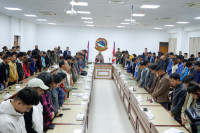Opinion
Implementing federalisation
People want sincere effort from political parties, government and bureaucracy to implement the constitution and end the transition
Trilochan Pokharel & Rajendra Adhikari
After the promulgation of the constitution last year, implementation of federalism has become extremely important. With a long list of arguments for and against the constitutional provisions, the issue of federalism has been discussed thoroughly. Scholars come up with various opinions, which they use to weaken other arguments. This article is not a criticism of the constitution; rather, it sheds light on public understanding of the constitution and offers some ideas to implement constitutional provisions regarding federalism.
Contentious issues
The argument that ‘Nepali leaders do not have experience in federalism so it cannot be implemented’ is baseless as expecting experience in a prospective system is absurd. Advancing such an argument is simply being reluctant to honour the spirit of the constitution. State systems evolve and people adapt to them. Nevertheless, Nepal is not the only country to adopt federalism and experiences of other federal countries provide a useful global perspective. It is wiser to see the prospects of federalism and develop state apparatus, including the political parties and the bureaucracy, accordingly.
The argument that local governments would not have the capacity to deliver unless the constitution is amended to revise the devolution of authority to the local level is an outcome of inadequate schooling about the principles of federalisation. Rather, discourse and preparation are required to design local institutions in such a way that they can effectively deliver the constitutional provisions. The evaluation of federal constitutions around the globe confirms that Nepal’s attempt to empower local government is unique and progressive in terms of narrowing the distance between the state and the people. The Local Body Restructuring Commission (LBRC) is struggling to suggest viable local units that can actually deliver the constitutional provisions. For this, more than population and geography, constitutional distribution of functions should be considered. And there lies the challenge: striking a careful balance between the principle of subsidiarity and economies of scale to determine a plausible solution in size of local units. A discourse beyond the size and number of local units is required to institutionalise local governments in the federal system.
Then there is the issue about the management of bureaucracy in the federal structure. The current bureaucracy was formed under a unitary system and is thus centralised in nature. Studies show that more than 60 percent of civil servants are placed in Kathmandu Valley due to the capital-centric psychology of civil servants. The government is facing a hard time to ensure an adequate number of officials in sub-national level organisations, which is obstructing public service delivery. Given this tendency, there is a general concern that the government will have a tough time to reorganise and manage the current bureaucracy once we adopt federalism.
However, this issue has been perceived in an unnecessarily complex manner. There is a simple principle that ‘structure follows functions, staffing follows structure’. The constitution has clearly defined functional allocations; now we need is to unbundle those functions and define the structure accordingly. After the structure is defined as per the constitution, staffing should not be an issue. However, demands to transfer bureaucrats to privileged provisions are complicating the issue.
Way forward
Despite complexities in the implementation of the constitution, there are some simple ways to move forward. Casual strategies and efforts cannot institutionalise the constitutional provisions. A broader understanding among the major political forces with a strategic roadmap is required to move ahead.
Rather than criticising the statute, it would be wise to accept the constitutional provisions and prepare accordingly. It is obvious that the current constitution is a document of compromise, and hence, has room for improvement. However, we can still begin implementing it. Once committed, we have plenty of opportunities to amend the provisions if things do not go as planned.
We should also understand the different roles of federal, provincial and local governments. Generally, the federal government would be engaged in policy and regulatory works, provincial governments to liaise and ensure provisions of public service and local governments to deliver the frontline services. This requires following the constitutional allocations of functions accordingly. The political parties and the government must launch a massive constitution education campaign among themselves and the general public to dispel misunderstandings.
We should define institutional arrangements, which will allow the government to take several other decisions like arrangement of necessary infrastructures, facilities, financing and staff.
Lastly, the government and political parties should be honest enough to concentrate their efforts on implementing constitutional provisions. Our analysis from various nation-wide interactions confirms that there is only a little dissatisfaction on the technical aspects of the constitution. However, what people want is sincere effort from the political parties, government and bureaucracy to implement the constitution and end the transition within the agreed upon time frame.
Pokharel and Adhikari are Director of Studies at Nepal Administrative Staff College




 13.12°C Kathmandu
13.12°C Kathmandu










